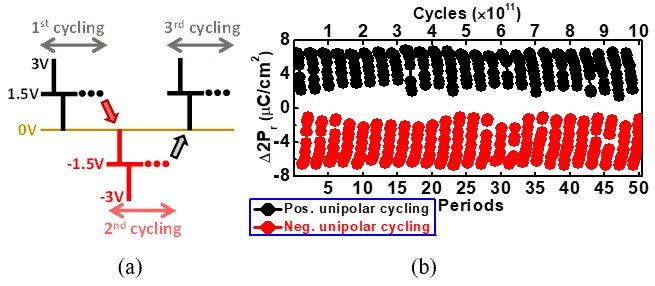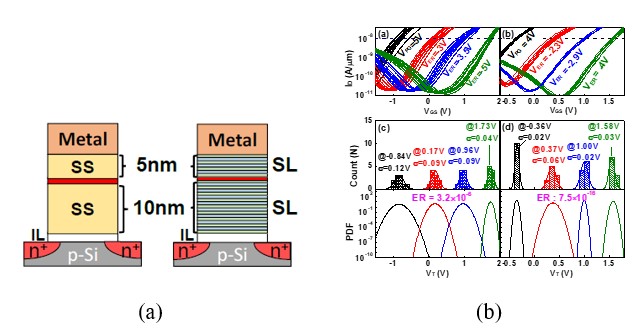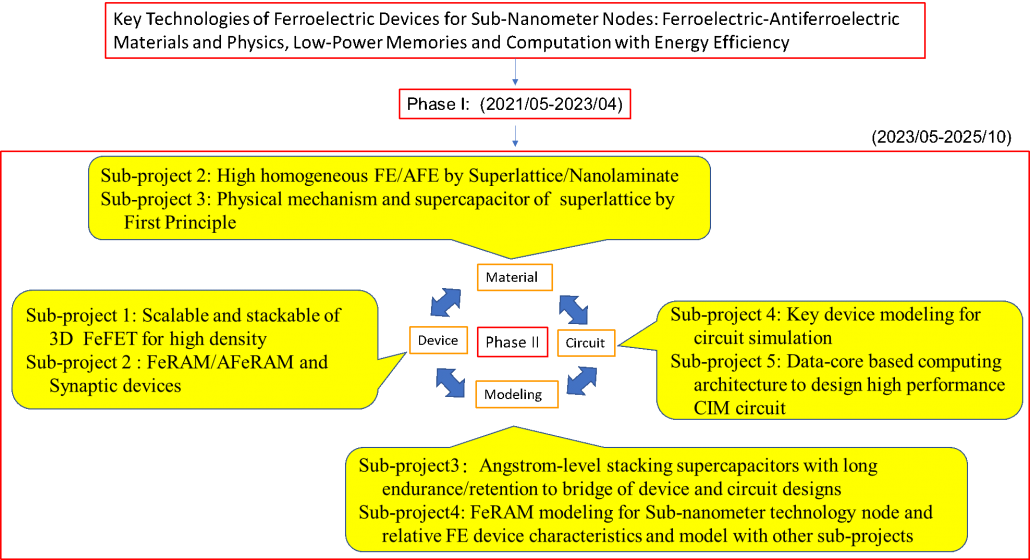Project
Key Technologies of Ferroelectric Devices for Sub-Nanometer Nodes: Ferroelectric-Antiferroelectric Materials and Physics, Low-Power Memories and Computation with Energy Efficiency
PI
Co-PI
Anti-ferroelectric Technology and Operation
Anti-ferroelectric (AFE) capacitors exhibit independent polarities on fatigue and leakage current for unipolar operation. In this work, opposite polarity cycling recovery (OPCR) with alternate polarity cycling is proposed for the first time to restore a fatigued polarization and leakage current back to its initial state, which involves the oxygen vacancy redistribution by opposite polarity cycling. Furthermore, AFE capacitor with OPCR demonstrates 50 periods and accumulation to 1×1012 switching cycles. This result exhibits the nondegradation and complete restoration of Pr, as shown in Fig. 1. The proposed access scheme paves the way for AFE-based eDRAM applications. The relevant research results have been published in the 2022 International Electron Devices Meeting (IEDM 32.5) and invited for publication in IEEE Transactions on Electron Devices (T-ED).

Fig. 1. (a) Opposite polarity cycling recovery (OPCR) of alternate polarity cycling sequences. (b) The AFE capacitor with OPCR for 50 periods with alternate polarity and accumulates to 1×1012 switching cycles.
Superlattice Deposition Technology with High Ferroelectric Phase HZO
This work adopts the superlattice (SL) ferroelectric oxide deposition method to enhance the ferroelectric phase ratio. This SL deposition technology is utilized for the double-layer ferroelectric structure to improve the stability of multi-level memory, as shown in Fig. 2. Compared to the traditional solid-solution (SS)-HZO, SL-HZO not only reduces the operating voltage (VPG/ER=4V) but also exhibits ultra-low error rate = 7.5×10-16, high 109 cycling for 2-bit endurance and stable data retention > 104 s. In addition, the SL-HZO also improves device variation of device-to-device (D2D) with nanoscale 3D FET. The homogeneous and coherent film of ferroelectric layer is highly demanded for FeFET scaling with high-density and high-performance. The relevant research results have been published in the 2022 International Electron Devices Meeting (IEDM 36.6).

Fig. 2. (a) Schematic diagram of solid-solution (SS), superlattice (SL) for double-layer ferroelectric structure. (b) For 4-state memory operation, the stability of read error rate is improved for SL as compares to SS.
Key Modeling Technologies for Antiferroelectric (AFE) / Ferroelectric (FE:)
- We have successfully developed a physical model capable of describing the switching dynamics and frequency response of AFE/FE HZO. Our research results have been presented at IEEE 2021 (Sec. 15.4).
- We have conducted modeling and characterization for switching dynamics of fatigued AFE/FE HZO. We have modeled the domain pinning probability considering fatigue mechanisms mediated by oxygen vacancy and charge injection. Our research results have been presented at IEEE 2022 (Sec. 13.4).
- Our developed models can be used for future AFE/FE memory design and applications.


